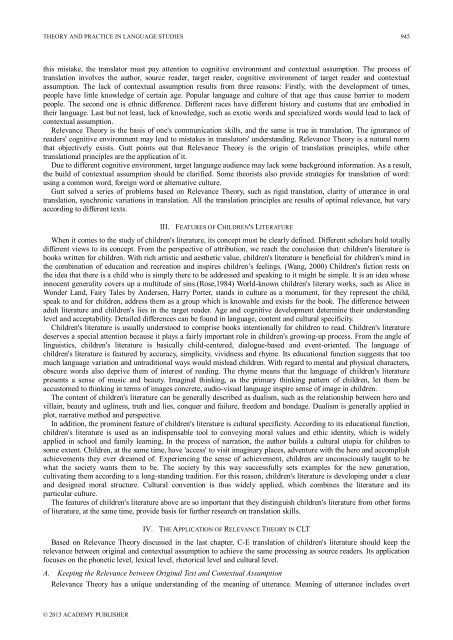Theory and Practice in Language Studies Contents - Academy ...
Theory and Practice in Language Studies Contents - Academy ...
Theory and Practice in Language Studies Contents - Academy ...
You also want an ePaper? Increase the reach of your titles
YUMPU automatically turns print PDFs into web optimized ePapers that Google loves.
THEORY AND PRACTICE IN LANGUAGE STUDIES 945this mistake, the translator must pay attention to cognitive environment <strong>and</strong> contextual assumption. The process oftranslation <strong>in</strong>volves the author, source reader, target reader, cognitive environment of target reader <strong>and</strong> contextualassumption. The lack of contextual assumption results from three reasons: Firstly, with the development of times,people have little knowledge of certa<strong>in</strong> age. Popular language <strong>and</strong> culture of that age thus cause barrier to modernpeople. The second one is ethnic difference. Different races have different history <strong>and</strong> customs that are embodied <strong>in</strong>their language. Last but not least, lack of knowledge, such as exotic words <strong>and</strong> specialized words would lead to lack ofcontextual assumption.Relevance <strong>Theory</strong> is the basis of one's communication skills, <strong>and</strong> the same is true <strong>in</strong> translation. The ignorance ofreaders' cognitive environment may lead to mistakes <strong>in</strong> translators' underst<strong>and</strong><strong>in</strong>g. Relevance <strong>Theory</strong> is a natural normthat objectively exists. Gutt po<strong>in</strong>ts out that Relevance <strong>Theory</strong> is the orig<strong>in</strong> of translation pr<strong>in</strong>ciples, while othertranslational pr<strong>in</strong>ciples are the application of it.Due to different cognitive environment, target language audience may lack some background <strong>in</strong>formation. As a result,the build of contextual assumption should be clarified. Some theorists also provide strategies for translation of word:us<strong>in</strong>g a common word, foreign word or alternative culture.Gutt solved a series of problems based on Relevance <strong>Theory</strong>, such as rigid translation, clarity of utterance <strong>in</strong> oraltranslation, synchronic variations <strong>in</strong> translation. All the translation pr<strong>in</strong>ciples are results of optimal relevance, but varyaccord<strong>in</strong>g to different texts.III. FEATURES OF CHILDREN'S LITERATUREWhen it comes to the study of children's literature, its concept must be clearly def<strong>in</strong>ed. Different scholars hold totallydifferent views to its concept. From the perspective of attribution, we reach the conclusion that: children's literature isbooks written for children. With rich artistic <strong>and</strong> aesthetic value, children's literature is beneficial for children's m<strong>in</strong>d <strong>in</strong>the comb<strong>in</strong>ation of education <strong>and</strong> recreation <strong>and</strong> <strong>in</strong>spires children‟s feel<strong>in</strong>gs. (Wang, 2000) Children's fiction rests onthe idea that there is a child who is simply there to be addressed <strong>and</strong> speak<strong>in</strong>g to it might be simple. It is an idea whose<strong>in</strong>nocent generality covers up a multitude of s<strong>in</strong>s.(Rose,1984) World-known children's literary works, such as Alice <strong>in</strong>Wonder L<strong>and</strong>, Fairy Tales by Andersen, Harry Porter, st<strong>and</strong>s <strong>in</strong> culture as a monument, for they represent the child,speak to <strong>and</strong> for children, address them as a group which is knowable <strong>and</strong> exists for the book. The difference betweenadult literature <strong>and</strong> children's lies <strong>in</strong> the target reader. Age <strong>and</strong> cognitive development determ<strong>in</strong>e their underst<strong>and</strong><strong>in</strong>glevel <strong>and</strong> acceptability. Detailed differences can be found <strong>in</strong> language, content <strong>and</strong> cultural specificity.Children's literature is usually understood to comprise books <strong>in</strong>tentionally for children to read. Children's literaturedeserves a special attention because it plays a fairly important role <strong>in</strong> children's grow<strong>in</strong>g-up process. From the angle ofl<strong>in</strong>guistics, children's literature is basically child-centered, dialogue-based <strong>and</strong> event-oriented. The language ofchildren's literature is featured by accuracy, simplicity, vividness <strong>and</strong> rhyme. Its educational function suggests that toomuch language variation <strong>and</strong> untraditional ways would mislead children. With regard to mental <strong>and</strong> physical characters,obscure words also deprive them of <strong>in</strong>terest of read<strong>in</strong>g. The rhyme means that the language of children's literaturepresents a sense of music <strong>and</strong> beauty. Imag<strong>in</strong>al th<strong>in</strong>k<strong>in</strong>g, as the primary th<strong>in</strong>k<strong>in</strong>g pattern of children, let them beaccustomed to th<strong>in</strong>k<strong>in</strong>g <strong>in</strong> terms of images concrete, audio-visual language <strong>in</strong>spire sense of image <strong>in</strong> children.The content of children's literature can be generally described as dualism, such as the relationship between hero <strong>and</strong>villa<strong>in</strong>, beauty <strong>and</strong> ugl<strong>in</strong>ess, truth <strong>and</strong> lies, conquer <strong>and</strong> failure, freedom <strong>and</strong> bondage. Dualism is generally applied <strong>in</strong>plot, narrative method <strong>and</strong> perspective.In addition, the prom<strong>in</strong>ent feature of children's literature is cultural specificity. Accord<strong>in</strong>g to its educational function,children's literature is used as an <strong>in</strong>dispensable tool to convey<strong>in</strong>g moral values <strong>and</strong> ethic identity, which is widelyapplied <strong>in</strong> school <strong>and</strong> family learn<strong>in</strong>g. In the process of narration, the author builds a cultural utopia for children tosome extent. Children, at the same time, have 'access' to visit imag<strong>in</strong>ary places, adventure with the hero <strong>and</strong> accomplishachievements they ever dreamed of. Experienc<strong>in</strong>g the sense of achievement, children are unconsciously taught to bewhat the society wants them to be. The society by this way successfully sets examples for the new generation,cultivat<strong>in</strong>g them accord<strong>in</strong>g to a long-st<strong>and</strong><strong>in</strong>g tradition. For this reason, children's literature is develop<strong>in</strong>g under a clear<strong>and</strong> designed moral structure. Cultural convention is thus widely applied, which comb<strong>in</strong>es the literature <strong>and</strong> itsparticular culture.The features of children's literature above are so important that they dist<strong>in</strong>guish children's literature from other formsof literature, at the same time, provide basis for further research on translation skills.IV. THE APPLICATION OF RELEVANCE THEORY IN CLTBased on Relevance <strong>Theory</strong> discussed <strong>in</strong> the last chapter, C-E translation of children's literature should keep therelevance between orig<strong>in</strong>al <strong>and</strong> contextual assumption to achieve the same process<strong>in</strong>g as source readers. Its applicationfocuses on the phonetic level, lexical level, rhetorical level <strong>and</strong> cultural level.A. Keep<strong>in</strong>g the Relevance between Orig<strong>in</strong>al Text <strong>and</strong> Contextual AssumptionRelevance <strong>Theory</strong> has a unique underst<strong>and</strong><strong>in</strong>g of the mean<strong>in</strong>g of utterance. Mean<strong>in</strong>g of utterance <strong>in</strong>cludes overt© 2013 ACADEMY PUBLISHER
















